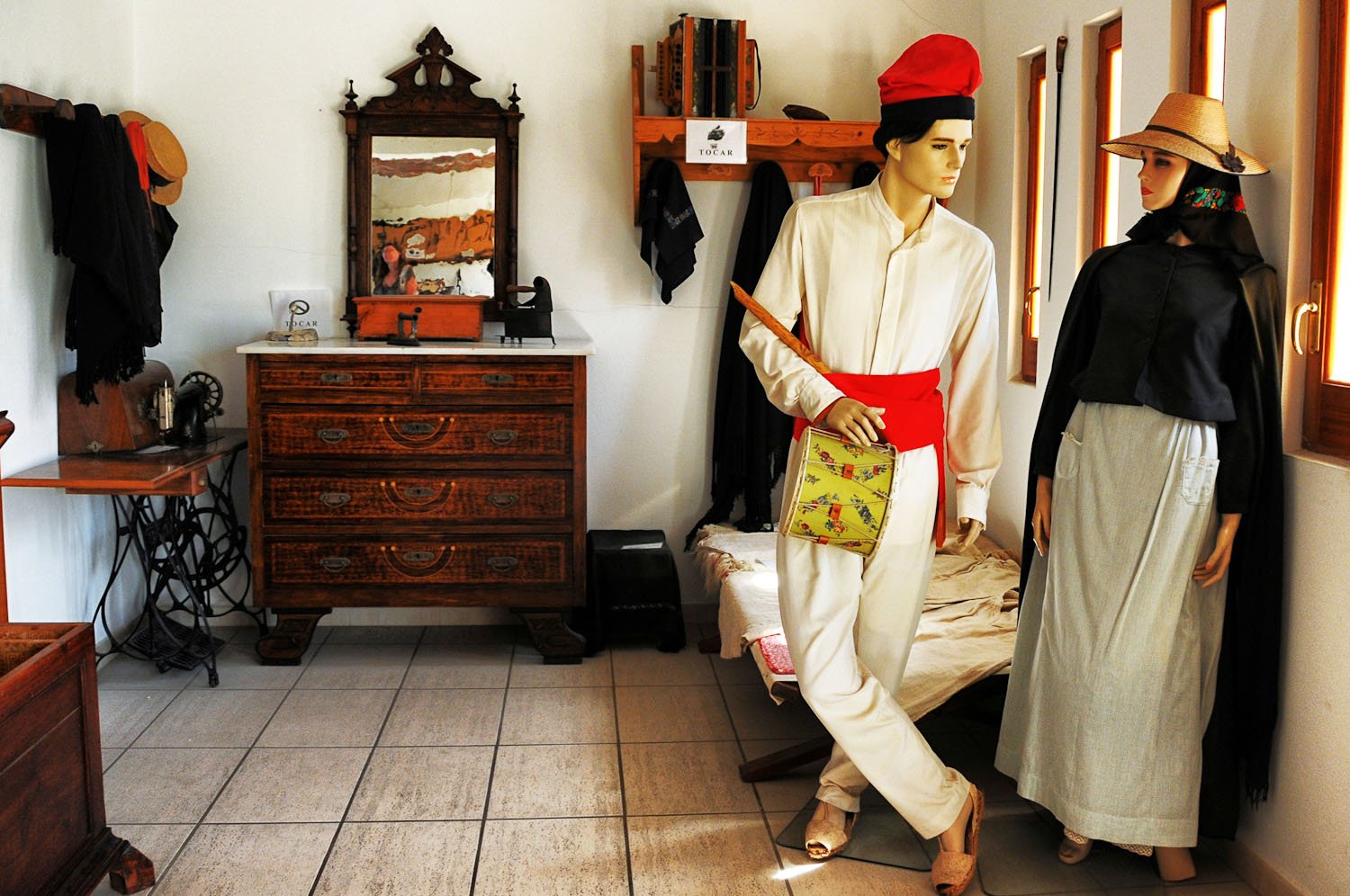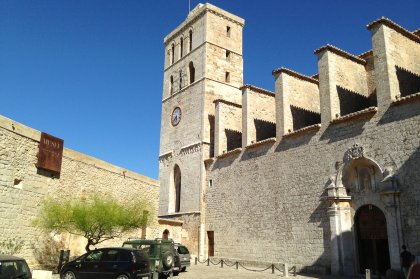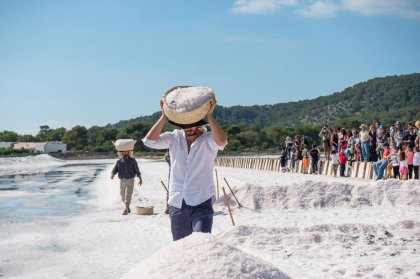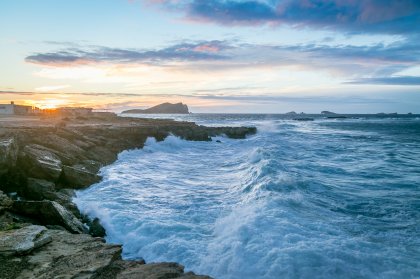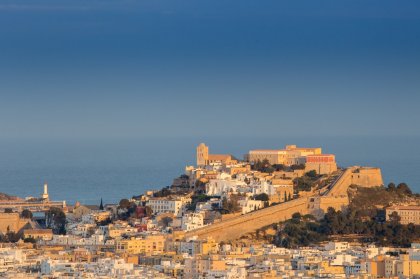Ibiza and Formentera have a long, colourful history stretching back thousands of years. Over that time, they have served as a crucible of cultures from around the Mediterranean and North Africa. This long, distinguished past is the background of the multicultural society of the islands today.
Along with Mallorca and Menorca, as well as over 40 islets, Ibiza and Formentera form part of the Balearic Islands, situated in the western Mediterranean Sea, around 150 km off the east coast of Spain.
Prehistory
There is evidence to suggest that Ibiza was settled by the same Bronze Age inhabitants as the other Balearic Islands, in particular, Menorca. This dates human occupation on Ibiza and Formentera to over 3000 years ago. Burial remains on Formentera and cave paintings found at Ses Fontanelles (north of San Antonio) as well as a number of bronze axes and discs found near San Juan and San Agustín all back up this claim.
The Phoenicians
However, we can say the island really got on the map when it was settled in the mid-7th Century BCE by traders from the mainland in search of new commercial outposts in the Mediterranean. So, who were these traders?
At that time, two civilisations dominated the trade in the Mediterranean, the Greece and the Phoenicians, later called Carthagians by their legendary capital of Carthage located in modern-day Tunisia. They led a largely peaceful co-existence, the Greeks focusing on the eastern and central Mediterranean and the Phoenicians (called the Punic people by the Romans) seeking to expand into the western Mediterranean and the Atlantic. In mainland Spain, the latter founded cities such as Gades (modern-day Cádiz - often claimed to be Europe’s oldest city), Alicante, and New Carthage (now Cartagena).
It was from these trading centres in Spain that the first settlers began to explore the Balearic Islands, finding in Ibiza the perfect base. Strategically situated astraddle trading routes joining all parts of the Mediterranean, it allowed them easy access to the other Balearic Islands, mainland Spain, southern France and North Africa.
In the year 654 BCE they first arrived on Ibiza, building a settlement at Sa Caleta, a bay in the south of Ibiza - the remains of which have been preserved to this day. Shortly afterwards, they founded Ibiza Town by the name of Ibossim or Iboshim, in honour of one of their principal gods, Bes.

First Punic settlement on Ibiza in Sa Caleta
Its population in the centuries leading up to the birth of Christ would have been around 5-6,000. Perhaps the clearest legacy of that time is the necropolis or burial grounds situated on the hillside of Puig des Molins in Ibiza Town, home to the world's largest collection of Punic artefacts.
Enterprising traders, they quickly developed Ibiza Town into a very important trading centre with a large harbour and strong city walls (although the walls we can see today were built much, much later). They even minted their own coins to facilitate trade - a sure sign of the island’s importance and recognition. The most important of the goods traded was 'white gold' - salt. The Salinas salt pans were constructed by the Punic people and are still in use today.

Other mainstays of their commerce were fish sauce (known in the ancient world as garum), wool, and a purple dye that was highly treasured throughout the Mediterranean and Near East. Over time, the Punic people spread out over the entire island, practising agriculture - in particular, olive production - and small-scale animal husbandry.
When it came to beliefs, the Punic folk worshipped a wide number of deities dating back to their ancestors at Carthage and even earlier, to the Phoenicians from whom they originally descended. In their pantheon, four gods stand out: Melqart, the god of the sea, the fearful Baal or Moloch; Tanit, the goddess of fertility - whose image is synonymous with Ibiza - and the mischievous Egyptian god, Bes.
The Romans
Towards the final centuries of the millennium before Christ, Carthage’s supremacy over the Mediterranean became increasingly challenged by the rise of a dynamic new power: Rome. This led to a series of wars between the two civilisations. After the second such conflict, the Roman Republic was triumphant and, eventually, in 123 BCE, the Balearic Islands fell under their control.
The Romans called Ibiza, Ebusus. Despite its close ties to Carthage, Ibiza negotiated a favourable treaty with the Romans, sparing it from destruction and permitting it to continue its Carthaginian-Punic institutions, traditions and even coinage until well into the days of the Roman Empire, when it became an official Roman municipality. Evidence of the Roman occupation can still be seen by the gates at the entrance to Dalt Vila, the fortified old town of Ibiza Town, where there are two copies of Roman statues.
Historical references to today: Ibiza's traditional whitewashed houses
Ibiza's architecture, in particular, its traditional whitewashed buildings, is unique and has a rich history tied to the use of local materials and practical needs. Whitewashing is a common tradition throughout the Mediterranean, known for its practical benefits in hot climates. In Ibiza, it dates back to the Punic people and the Romans.
The primary reason for whitewashing buildings with limestone is to reflect the intense sunlight, keeping the interiors cooler. Limestone, particularly in the form of limewash (a mixture of limestone and water), also has natural antibacterial properties. As Ibiza has an abundance of limestone, it has always been a readily available and cost-effective material for construction and maintenance.
The consistent use of white limewash creates a sense of uniformity and identity across the island. Indeed, it has become a defining characteristic of Ibizan architecture. Today, the whitewashed buildings are preserved as part of Ibiza’s cultural heritage. They also contribute to the island’s charm, attracting tourists who appreciate the traditional and picturesque scenery.
Post-Roman Ibiza
After the decline of Rome in the late 5th century CE, our knowledge of Ibiza becomes cloudier owing to the lack of historical record. During subsequent centuries, Ibiza underwent invasions by the Vandals and the Byzantines. The island continued to enjoy a degree of independence under the Byzantine Empire. Improvements in irrigation and the introduction of a share-cropping system are due to Byzantine influence. One of the few relics of this epoch is the underground chapel at Santa Agnès.
The arrival of the Moors
Spain fell to the North African Muslims aka Moors in 711 CE In the first decade of the 11th century CE, Ibiza fell under the control of the Islamic kingdom or taifa of Dénia, which ruled over part of what is now the coast and interior of Valencia. In 1015, the taifa conquered Ibiza, renaming it Yebisah. Islamic settlers, especially Berbers from North Africa, began to settle on the island, continuing and expanding the agricultural practices of the island up till then, aided by their extensive knowledge of irrigation techniques.
They lived in small rural communities made up of a few houses - sometimes fortified - known as an alquería. The inhabitants eked out a living through horticulture and rearing livestock. Adequate irrigation was the key and, even today, you can find examples of Arab-influenced irrigation structures dotted about the island’s landscape (one of the best examples are the fields known as Ses Feixes on the outskirts of Ibiza Town that supplied local produce for the city).
The Islamic period left a lasting influence on Ibiza. Even today, you can see it in local architectural styles, folk customs (such as the ball pagès or farmer’s dances), traditional costumes, musical instruments, and - of course - in the distinct variety of Catalan spoken on the island known as Ibicencan.

Historical references to today: dry stone walls
Dry stone walls have been built by all the ancient civilisations that have existed around the Mediterranean, including the Phoenicians, Carthaginians, Greeks, Romans and Moors, as these civilisations recognised the importance of cultivating steep and rocky terrain for agriculture. During the Middle Ages, the use of dry stone walls continued.
The stones anyway had to be collected from the fields so that they could be cultivated. These were then used to build boundary walls or, in hilly terrain, to fortify the faces of terraces.
Traditionally, the stones are piled on top of each other without any fixing material such as clay. In well-built walls, the stones are fitted together so skillfully that they are extremely stable - as the many centuries-old stone walls on Ibiza and Formentera prove. Nowadays, this art has almost been lost and cement is often used inside the wall.
The Reconquest
Over the 13th to 15th centuries, control of Spain was wrested back from the Muslims by a series of military campaigns waged by the Christian kingdoms of northern Spain. On 8 August, 1235, Ibiza was conquered by a force organised by the ruler of the Crown of Aragon, Jaume I. The local Muslim population was deported, and Christians arrived from Catalonia on the mainland to replace them.
The Catalans also tore down the Arab mosque at the summit of Ibiza Town and built the present day cathedral in the fortified old town Dalt Vila on its foundations. Other changes to the island included the renaming of its villages after Christian Saints, and the construction of churches, the oldest of which are in Santa Eulalia, San Antonio, San Miguel and Sant Jordi.

In the following centuries, Ibiza became something of a social and economic backwater as its nominal rulers on the mainland paid little attention to it. During this time Ibiza became known by its Catalan name, Eivissa. This has been widely adopted in recent years and is commonly used nowadays as an alternative to the Spanish name of Ibiza.
And while we’re on the subject of Ibiza in the Middle Ages, each year the city hosts a medieval festival in May, allowing visitors to get a taste of the atmosphere on the island back then.
Pirates on the coast!
From the 16th century CE onwards, Ibiza was increasingly subject to attack by pirates, the most notable and fearsome of which were known as Barbary Corsairs, from North Africa. These buccaneers - mostly of Berber and Ottoman origin - sought plunder and slaves for their vibrant slave trade. The response of the largely defenceless Ibizan farming communities was to build imposing defensive churches with fortified walls, in which they could seek shelter in the event of a raid.
A further precaution was the construction of a series of lookout towers along the island’s coastline. By means of beacons, the towers could warn of an impending attack, giving villagers the precious time to take refuge in the churches and prepare their rudimentary resistance. A number of these towers can still be seen today.

Historical references to today: Can Marça caves
The dripstone caves of Can Marça are formed from limestone, which is common in the geology of Ibiza. Over thousands of years, the caves were carved out by the erosive action of water, creating a system of chambers with intricate dripstone formations like stalagmites and stalactites.
In the 18th and 19th centuries, it was used by smugglers to store contraband goods, such as tobacco, alcohol, and textiles. Its remote location and hidden entrances made it an ideal hiding place away from the eyes of authorities. Legend and lore: The cave is also rich in legend and folklore, with stories of pirates and hidden treasures adding to its mystique.
Ibiza in modern times
The island maintained its structures of self-government up until 1715, when King Philip V of Spain abolished the local government's autonomy. Throughout the 18th and 19th centuries and, indeed, well into the 20th century, Ibiza suffered an ongoing decline in its economic, social and political development, becoming little more than a neglected backwater.
The growth of tourism
With the introduction of a regular ferry from the mainland in the early 1930's, tourism began to evolve, bringing a much-needed change in the island’s fortunes. At the same time, the rise of fascism in Europe also saw a number of well known artists and writers seek shelter on Ibiza, the start of a trend that would see it become a haven for free-thinkers and bohemian spirits worldwide.
During the years 1939-1975, when Spain was under the dictatorship of General Franco, Ibiza began a transition from almost total obscurity to relative fame as the tourist industry evolved. The development of major beach resorts, the establishment of large hotels, the resurrection of its airport and the arrival of tour operators saw the island’s population nearly double in the 1960's and 70's, largely as a result of the travel boom that drew builders and tourism workers from the mainland and holidaymakers from far and wide.
After Franco’s death in 1975, the arrival of democracy in the late 1970s led to the Statute of Autonomy of the Balearic Islands. Today, Ibiza is part of the Balearic Autonomous Community, along with Mallorca, Menorca and Formentera.
Nowadays, Ibiza (or Eivissa, as it is commonly called in the local language, Ibicencan) is one of Europe’s top tourist destinations thanks to its exceptional natural beauty, pristine waters, famed nightlife and gastronomy, and excellent infrastructure. This success is reflected in the number of tourists who visit each season: over 3 million!
Read more
Find here some more information about the history of Formentera.
HEADER IMAGE | Museo de Etnografia de Formentera
